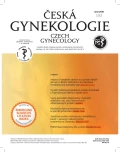Various approaches of endometrial preparation for frozen-thawed embryo transfer
Authors:
J. Vodička 1; M. Dvořan 1; K. Smékalová 1; Ľ. Michnová 2
; P. Hejtmánek 1; K. Lehnertová 1; J. Dostál 1
; M. Pešková 1; M. Annenková 1; R. Pilka 1
Authors‘ workplace:
Porodnicko-gynekologická klinika LF UP a FN, Olomouc, přednosta prof. MUDr. R. Pilka, Ph. D.
1; IVF Clinic, Olomouc, vedoucí lékař MUDr. Š. Machač, Ph. D.
2
Published in:
Ceska Gynekol 2018; 83(1): 24-28
Overview
Objective:
Various approaches of endometrial preparation for frozen-thawed embryo transfer.
Design:
Retrospective analysis.
Setting:
Department of Obstetric and Gyneacology, Faculty of Medicine, Palacky University, University Hospital Olomouc.
Methods:
Effectivity of frozen-thawed embryo transfers was carried out between January and August 2017 in the IVF unit at the University Hospital Olomouc. Results were compared among groups A, B, C with various approaches of endometrial preparation. Group A – natural ovulating cycle, group B – artificial cycle with oral estrogen, vaginal gestagen and group C – artificial cycle with transdermal estrogen and vaginal gestagen. One blastocyst (two blastocyst in five cycles) was transferred on day 6 post ovulation (group A) or after 6 days of using gestagens (group B, C).
Results:
The highest pregnancy rate was observed in group C (56%), similar pregnancy rate was found in group B (52%) and the lowest was seen in group A (22%). All pregnancies in group A continued over 12 weeks, in group B continued 57 percent and in group C continued 56 percent of pregnancies.
Conclusion:
Frozen-thawed embryotransfers in natural cycles are highly time-consuming. Our study has demonstrated the lowest effectivity of frozen-embryotransfer in natural cycles. Artificial cycles managed by oral or transdermal form of estrogen have shown better results.
Keywords:
frozen-thawed embryotransfer, natural cycle, artificial cycle, pregnancy rate
Sources
1. Braga, DP., Setti, AS., Figueira, RC., et al. Freeze-all, oocyte vitrification, or fresh embryo transfer? Lesson from an egg-sharing donation program. Fertil Steril, 2016, 106, p. 615–622.
2. Cedars, M. Fresh versus frozen: initial transfer or cumulative cycle results: how do we interpret results and design studies? Feril Steril, 2016, 106, 2, p. 251–256.
3. Cerrillo, M., Herrero, L., Guillen, A., et al. Impact of endometrial preparation protocols for frozen embryo transfer on live birth rates. Rambam Maimonidess Med J, 2017, 8(2), p. e0020.
4. Davar, R., Janati, S., Mosheni, F., et al. A comparison of the effects of transderma estradiol and estradiol valerate on endometrial receptivity in frozen-thawed embryo transfer cycles: a randomized clinical trial. J Reprod Infertility, 2016, 17(2), p. 97–103.
5. Diemant, FC., Petersen, CG., Mauri, AL., et al. Fresh embryos versus freeze-all embryos – transfer strategies: Nuances of a meta-analysis. JBRA Assisted Reprod, 2017, 21(3), p. 260–272.
6. Gelbaya, TA., Nardo, LG., Hunter, HR., et al. Cryopreserved – thawed embryotransfer in natural or down-regulated hormonally controlled cycles: a retrospective study. Fertil Steril, 2006, p. 603–609.
7. Healy, MW., Yamasaki, M., Patounakis, G., et al. The slow growing embryo and premature progesterone elevation: compounding factors for embryo-endometrial asynchrony. Hum Reprod, 2017, 32(2), p. 362–367.
8. Huser, M., Crha, I., Žáková, J., et al. Onkofertilita – nový směr reprodukční medicíny. Čes Gynek, 2011, 76(2), s. 91–99.
9. Chambers, GM., Wand, H., Macaldowie, A., et al. Population trends and live birth rates associated with common ART treatment strategies. Hum Reprod, 2016, 31(11), p. 2632–2641.
10. Chen, YH., Wang, Q., Zhang, YN., et al. Cumulative live birth and surplus embryo incidence after frozen-thaw cycles in PCOS: how many oocytes do we need? J Assist reprod Genet, 2017, 3.
11. Kalem, Z., Kalem, MN., Gurgan, T. Methods for endometrial preparation in frozen-thawed embryo transfer cycles. J Turkish-German Gyneacol Ass, 2016, 17(3). p. 168–172.
12. Liao, X., Dong, X., Zhang, H. Comparison between oral and vaginal estrogen usage in inadequate endometrial patients for frozen-thawed blastocyst transfer. Int J Clin Exp Pathol, 2014, 7(10), p. 6992–6997.
13. Michnová, L., Rumpíková, T., Dostál, J. Luteální podpora v programu IVF/ET. Čes Gynek, 2011, 76, 2, s. 104–107.
14. Peeraer, K., Couck, I., Debrock, S., et al. Frozen-thawed embryo transfer in a natural or mildly hormonally stimulated cycle in woman with regular ovulatory cycles: a RCT. Hum Reprod, 2015, 30, 11, p. 2552–2562.
15. Roque, M., Lattes, K., Serra, S., et al. Fresh embryo transfer versus frozen embryo transfer in in vitro fertilization cycles:a systematic review and meta-analysis. Fertil Steril, 2013, p. 152–162.
16. Shapiro, BS., Daneshmand, ST., Garner, FC., et al. Evidence of impaired endometrial receptivity after ovarian stimulation for in vitro fertilization: a prospective randomized trial comparing fresh and frozen thawed embryo transfer in normal responders. Fertil Steril, 2011, 96, 2., p. 344–348.
17. Xiao, Z., Zhou, X., Xu, W., et al. Natural cycle is superior to hormone replacement therapy cycle for vitrificated-preserved frozen-thawed embryo transfer. Systems biology in Repr. Medicine, 2012, 58, p. 107–112.
Labels
Paediatric gynaecology Gynaecology and obstetrics Neonatology Paediatrics Reproduction medicineArticle was published in
Czech Gynaecology

2018 Issue 1
- What Effect Can Be Expected from Limosilactobacillus reuteri in Mucositis and Peri-Implantitis?
- The Importance of Limosilactobacillus reuteri in Administration to Diabetics with Gingivitis
Most read in this issue
- Various approaches of endometrial preparation for frozen-thawed embryo transfer
- Antibiotic therapy in pregnancy
- Vein of Galen aneurysmal malformation
- Medroxyprogesteron acetate use to block LH surge in oocyte donor stimulation
